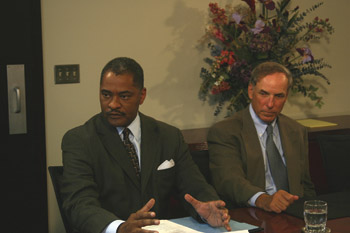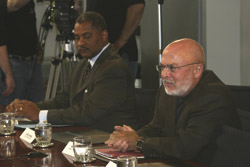Woody Cozad noted that the distribution of funds from the state legislature is pretty static. Of all the money allocated to higher education, 50 percent goes to the University of Missouri System. Of those funds, 50 percent goes to the Columbia campus, with UMKC being the next largest recipient at 25 percent. The remaining 25 percent is divided between the St. Louis and Rolla campuses.
“If Dr. Floyd announced tomorrow that the system is going to shift 5 percent of the budget, pull it out of UMSL and Rolla and send it to UMKC, there would be an explosion in Jefferson City that you cannot imagine,” he said. “So we are restrained by politics. The good news about the $255 million is it will keep coming.”

University of Missouri System Pres. Dr. Elson Floyd cautions panelists of the challenges and repurcussions associated with UMKC leaving the System.
He also noted that many nationally known state universities use money from state legislatures as only a portion of their total funding picture. The University of Michigan, for example, gets only 16 percent of its budget from the state. “That’s the future of any university that wants to elevate itself,” Cozad said.
Cozad also questioned whether the philanthropic community would jump in and cover the university’s expenses if the secession was successful. “It has not happened in a big way in the past,” he said.
Haines piggy-backed on that and asked if there was any proof that it would happen with the promise of local governance.
Cozad repeated what he’s been telling would-be philanthropists, “Put your money on the table and you’ll have a voice. The state doesn’t have more money. If you put 100, 200, 300+ million dollars on the table, nobody can say no to you.’”
But that creates another problem, Haines noted. The academicians at UMKC are concerned that business interests with money already are pushing their agendas.
Ray Coveney, the geosciences professor, said that his colleagues would not question the motivation for funding a program that helps the city. He highlighted a relatively new master’s program in social work. “We need more of those sorts of programs,” he said, “to be a great university.”
Haines wondered if money from the state is so tight, wouldn’t it be easier to attract money to pay for those types of programs with local—and connected—governance?
Coveney said he just doesn’t see it happening. A local board not only would have to raise the additional funds that would make the switch appealing, but it would also have to replace the $255 million that the state pours into the university each year. “That is simply not going to happen.”
Cozad redirected the conversation slightly by saying he didn’t think there was any interest in privatizing UMKC. The discussion is about local governance, which not only would have to pass the state constitutional test, but would be subjected to intense local politics and business interests.
“As much as I have problems with the System, replacing it with a local board does not impress me as a good idea,” he said. “If you want the local influence, you can get it by putting your money out on the table.”
Mary James, whose curator term just expired last year, said it’s a communications issue. “I don’t think people in Kansas City understand the System and what the System brings to the table.”
When Haines questioned her about her reaction to the statement that separation from the University of Missouri System would dramatically improve UMKC’s financial situation, she responded, “I don’t see how it could happen or how it could work.”

Ray Coveney has been with UMKC since 1971 and be-lieves accomplishments have occurred, but it lacks funds.
Floyd was adamant about dispelling the notion that the UMKC board of trustees doesn’t have a say in how the university is run. “They do have a significant voice,” he said. He noted a new image campaign that not only affects how the university is viewed in KC, but statewide and across the country.
Haines questioned the view shared by many in the media in Kansas City that UMKC is always going to be second-tier because of the flagship status of the Columbia campus. Mary James said that she has not seen any evidence of that on the board of curators, even arguing that the opposite is true. She brought up the budget process, the strategic planning process and the research agenda. “I don’t think of it as a zero-sum game,” she said, “that somebody has to lose for somebody else to gain.”
Kevin Lujin, the student advocate, said the curators consistently have been supportive of the Kansas City campus. As a native of central Missouri, he also believes that residents of the more rural area would not be supportive of a local governing board.
Haines continued with the thought that some believe UMKC to be “the redheaded step-child” of the University of Missouri System.
Cozad said it isn’t true. He pointed to the two occasions when a chancellor moved up to become president of the university system. Both times it was a UMKC chancellor. But he also disagreed with James’ statement that it’s not a zero-sum game.
“There’s a limited state budget and it is handed out in the same proportions every year,” he said. “That’s the definition of a zero-sum game. Columbia is the flagship of the System. If nobody moves, it remains the flagship. If everybody turns up their jets and tries to get better, that is a threat to Columbia.”
Cashill said that as long as that remained true, UMKC would never be able to achieve “its own distinct identity.”
Ted Beckett, while not arguing Cashill’s point, said that the private support that UMKC does receive is evidence to its level of prestige. Citing donations from Henry Bloch, the Miller Nichols family and the Katz (drug stores) family, he said that the trustees have been generous in their support.
Haines pushed the point of UMKC playing second fiddle to Columbia, to which Beckett responded with the history of the medical schools. Columbia’s was founded in 1844, while UMKC’s was founded in 1971.
Cozad cited other hurdles that UMKC faces, including one that the whole university system must clear. One is that the average campus CEO is on the job for five years. “You cannot fulfill an agenda in that amount of time,” he said. In Dr. Floyd’s short tenure as the president of the university system, all four campuses have changed chancellors.
Some of the more successful schools in Missouri have done so with periods of consistent leadership. Cashill agreed, adding that the most successful institution in the metro area—Johnson County Community College—has had the same leader for more than 20 years. Charles Carlsen “directs that campus toward a very specific focus—economic and business development,” Cashill said.
Dr. Floyd didn’t disagree with the idea that for the institution to be successful it must have a partnership with the community. In fact, he stated, “It must be an active and real partnership.”
Does It Stand a Chance?
To wrap it up, Haines wondered if the secession from the university had any chance of being successful. Cashill spoke of the need for a benefactor to put $100 million on the table, and he is willing to rename the university in his or her honor.
Recognizing that it was unlikely to find a donor to do that, he didn’t rule out significant changes in the structure of higher education.
So what might those be? Dr. Floyd, of the System, said there is a will—a personal will, a professional will and a political will—to improve the System, as long as it doesn’t interfere with the “core principles associated with a great, public, world-class university.”
Coveney, the geosciences professor, reminded the panelists that what may be practical today may not be tomorrow. “We need to do basic education for the students on this campus.”
Beckett, the former curator added, “the purpose of education is to teach people to think.”
